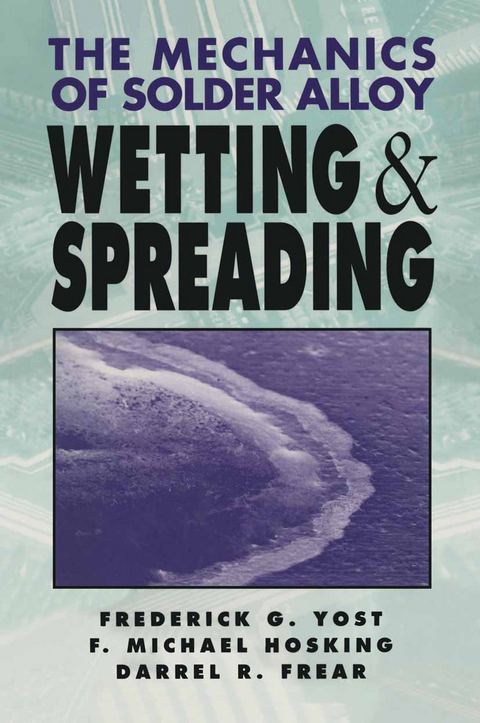
The Mechanics of Solder Alloy Wetting and Spreading
Springer-Verlag New York Inc.
9781468414424 (ISBN)
1. Introduction: The Mechanics of Solder Alloy Wetting and Spreading.- 1.1 Soldering in Electronics.- 1.2 The Wetting Problem.- References.- 2. Solderability Testing.- 2.1 Introduction.- 2.2 The “Numbers” Problem.- 2.3 The Consistency Problem.- 2.4 The Requirements Problem.- 2.5 The Aging Problem.- 2.6 Conclusions.- 2.7 Appendix.- References.- 3. Fluxes and Flux Action.- 3.1 Introduction.- 3.2 Flux History.- 3.3 Flux Requirements.- 3.4 Rosin-Based Fluxes.- 3.5 Gaseous Fluxes.- 3.6 Inorganic Fluxes.- 3.7 Effect of Solder Impurities on Solderability.- 3.8 Solderability Tests.- References.- 4. Reactive Wetting and Intermetallic Formation.- 4.1 Introduction.- 4.2 Analysis of Solder Spreading Kinetics.- 4.3 Contact Line Motion Over Obstacles.- 4.4 Metallurgy of the Moving Contact Line.- 4.5 Thermodynamic Calculation of the Ternary Pb-Sn-Cu System.- 4.6 Wetting Balance Studies on Cu6sn5 and Cu3Sn.- 4.7 Conclusion.- 4.8 Acknowledgments.- References.- 5. Loss of Solderability and Dewetting.- 5.1 Introduction.- 5.2 Characterization of Dewetting.- 5.3 Wetting Stability Diagrams.- 5.4 Dynamics of Wetting Instabilities: Physical Mechanisms.- 5.5 Intermetallic Formation.- 5.6 Conclusions.- 5.7 Acknowledgments.- References.- 6. Oxidation of Solder Coatings.- 6.1 Introduction.- 6.2 Tin-Lead-Copper System Metallurgy.- 6.3 Role of Oxides in Solderability Loss.- 6.4 Tin-Lead Oxidation.- 6.5 Solderability Assessment Via Oxides.- 6.6 Accelerated Aging.- 6.7 Future Directions.- References.- 7. Surface and Interface Energy Measurements.- 7.1 Abstract.- 7.2 Introduction.- 7.3 Basic Concepts.- 7.4 Equilibrium Conditions for a Curved Interface.- 7.5 Capillarity Effect in Solids.- 7.6 Experimental Techniques.- 7.7 Conclusions.- 7.8 Acknowledgments.- References.- 8. Advanced SolderingProcesses.- 8.1 Impetus for Change.- 8.2 Alternative Approaches to Promote Wetting.- 8.3 Alternate Heat Sources.- 8.4 Solder Bump Technology.- 8.5 Future Directions for Solder Process Technology.- 8.6 Acknowledgments.- References.- 9.0 Reliability-Related Solder Joint Inspection.- 9.1 Abstract.- 9.2 Motivation.- 9.3 Inspection Criteria.- 9.4 Inspection Technologies.- 9.5 Mantech/ADSP Solder Joint Inspection Example.- 9.6 Inspection Automation.- 9.7 Advanced Solder Joint Inspection Techniques.- 9.8 Conclusions.- References.- 10. The Properties of Composite Solders.- 10.1 Introduction.- 10.2 Mechanics of Solder Joints.- 10.3 Alloy Design for Thermomechanical Fatigue Resistance.- 10.4 Methods of Producing Composite Solder Alloys.- 10.5 In-Situ Composite Solders by Rapid Solidification.- 10.6 Properties of Composite Solder Alloys.- 10.7 Summary.- References.
| Zusatzinfo | 250 p. |
|---|---|
| Verlagsort | New York, NY |
| Sprache | englisch |
| Maße | 152 x 229 mm |
| Themenwelt | Sachbuch/Ratgeber ► Natur / Technik ► Garten |
| Informatik ► Theorie / Studium ► Algorithmen | |
| Informatik ► Weitere Themen ► Hardware | |
| Technik ► Elektrotechnik / Energietechnik | |
| Technik ► Maschinenbau | |
| ISBN-13 | 9781468414424 / 9781468414424 |
| Zustand | Neuware |
| Informationen gemäß Produktsicherheitsverordnung (GPSR) | |
| Haben Sie eine Frage zum Produkt? |
aus dem Bereich


